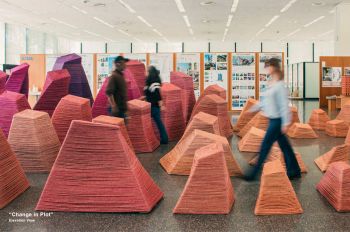Engineering as Architecture

For those interested in the design of new urban structures—particularly those that greatly increase density—is it better to focus one’s study on the principles of engineering, or architecture?
One visiting fellow at Illinois Institute of Technology's College of Architecture asked during a recent student workshop: Why not both at once?
When envisioning his role as the most recent Myron Goldsmith Visiting Fellow, architect Frank Barkow—co-founder of the prestigious Barkow Leibinger firm in Germany—wanted to directly honor the legacy of the chair’s namesake architect. The late Goldsmith (B.ARCH. ’39, M.ARCH. ’53) was an acclaimed architect and engineer, as well as a College of Architecture professor and graduate who studied under famed architect Ludwig Mies van der Rohe at Illinois Tech.
Barkow also held a lecture on the concepts during the College of Architecture’s 2024 spring lecture series.
“This idea of an architect-engineer, overlaying each other in a profound way, is kind of a unique one. All of this was fascinating for me, and overlaps with [my firm’s] own work,” Barkow says.
Barkow ran a 2024 workshop at the College of Architecture in which he guided students through a building he designed in the Chicago metro area: the Trumpf Smart Factory in Hoffman Estates, Illinois. There, Barkow had transformed an abandoned AT&T site into a cutting-edge automated factory. The project won an American Institute of Architects Honor Award for Architecture in 2019.
He also asked the workshop’s students to study the Ruck-A-Chucky Bridge, a 1978 Goldsmith project that spans the American River in California. The bridge connects a horseshoe-shaped roadway via a weave of cables that are stitched into the heights of surrounding hillsides.
Barkow then asked students to create their own architectural propositions utilizing similar principles of engineering. Each came up with a unique, urban design. One designed a layer of gardens suspended above Chicago’s “L” train tracks, creating a green space as well as an acoustical barrier. Another utilized the stitched-bridge technique of the Ruck-A-Chucky Bridge to envision urban bridges, with some housing elements, that span the spaces between downtown high-rises, even reaching across the Chicago River.
“I asked them to add density using engineering strategies to generate things like housing,” Barkow says. “They all did very interesting projects, embracing that concept of ‘engineering as architecture.’”
Barkow Leibinger’s current projects include the Estrel Tower, a 522-room, 44-story hotel that will be the tallest building in Berlin. Past projects include the Tour Total in Berlin and the Trutec Building in Seoul, Korea.
In addition to his recent position at Illinois Tech, Barkow has been a visiting professor at Princeton University, Cornell University’s College of Architecture, Art, and Planning, Harvard University, and the Royal College of Art in London, as well as other academic institutions in the United States.
The Myron Goldsmith Visiting Fellowship is named after Goldsmith, who worked with Mies before his long career at Skidmore, Owings & Merrill. He designed three landmark buildings on Illinois Tech’s Mies campus, including Arthur Keating Hall, Robert A. Pritzker Science Center, and John T. Rettaliata Engineering Center, and was inducted into the university’s Hall of Fame in 2019. Goldsmith’s wife and family established the Fellowship in his honor and to continue the tradition of design innovation Goldsmith labeled “Structural Architecture.”
“The Goldsmith Fellowship allows us to sustain Myron’s legacy,” explains COA Dean Reed Kroloff, “by introducing students to the world’s leading experts in architecture and engineering–and that wonderful space where they come inextricably together, the space Myron Goldsmith and his work occupied with such poise and elegance.”
Photograph by Deborah Mittelstaedt




